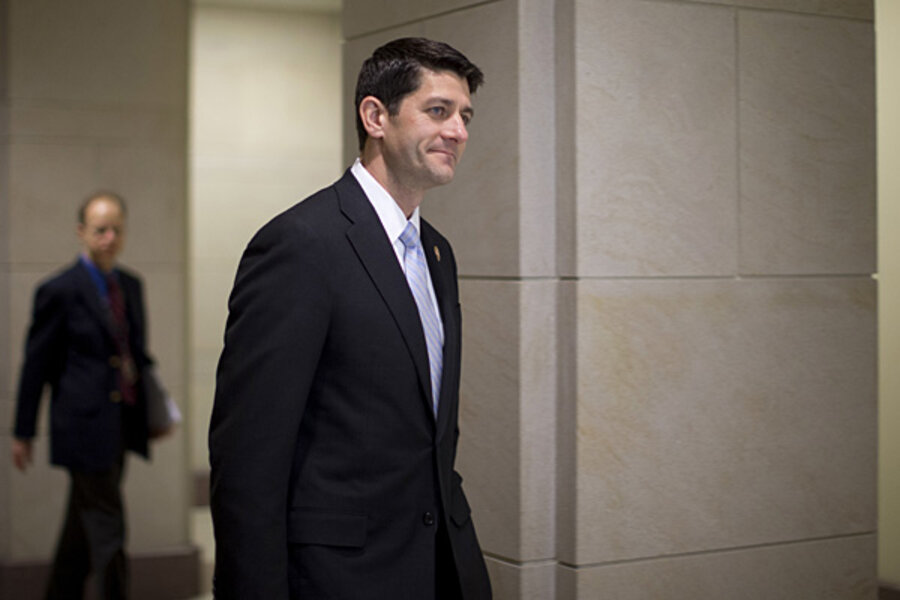How would Paul Ryan's tax plan work?
Loading...
House Budget Committee Chair Paul Ryan (R-WI) has proposed a controversial plan to balance the budget in 10 years, entirely by cutting planned spending by $4.6 trillion. While Ryan includes lots of specific spending cuts, his tax agenda is far less clear.
In some respects, the former GOP vice presidential candidate mimics the tactics of the 2012 campaign: Promise tax reform built around wildly ambitious but gauzy rate reductions without a word about how to pay for them.
His plan aspires to collapse today’s seven-bracket individual income tax to a two-rate system that would raise the same amount of money as current law. It would set a top rate of 25 percent, down from today’s 39.6 percent, though it calls this merely a goal. He’d repeal the Alternative Minimum Tax and slash the corporate rate from 35 percent to 25 percent. He’d do all this while maintaining revenues at levels projected in the Congressional Budget Office baseline—19.1 percent of Gross Domestic Product in 2023.
Interestingly, this 19.1% target assumes a revenue base that includes the tax hikes on high income households from Obamacare and the New Year’s Day fiscal cliff deal (the American Tax Relief Act).
Under the 2010 health law, high-income households will pay an additional 0.9 percent Medicare payroll tax and a new 3.8 percent levy on investment income such as capital gains and dividends. ATRA restored the old 39.6 percent tax bracket for top-bracket households.
Ryan would repeal all of Obamacare, including its new taxes. And he’d roll back the top tax rates in ATRA. But by assuming the level of revenues both laws would collect, Ryan makes it easier to balance his budget in 10 years since current law brings in higher revenues.
Thus this budget now accepts the extra revenues (though not the specific taxes) that Ryan and Hill Republicans so vehemently opposed just two months ago. This time last year, Ryan set a 2022 revenue target of 18.7 percent. Two years ago, he aimed for just 18.3 percent after a decade. Now, Ryan’s goal is 19.1 percent by 2023.
Because the Ryan plan would restructure the code but collect the same amount of revenue as today’s system, this budget would have to eliminate trillions of dollars in tax preferences.
Ryan, like President Obama and most members of Congress, prefers to call these loopholes. But in reality, targets would almost certainly include popular preferences such as deductions for mortgage interest, state and local taxes, and charitable gifts as well as the exclusion of employer-sponsored health insurance from taxable income.
In addition, cutting rates as deeply as Ryan wants would likely result in a huge tax cut for the very wealthy unless Congress raises rates on capital gains and dividends. Yet Ryan’s latest budget does little more than promise to simplify the tax code, whatever that means.
Ryan, however, is leaving the dirty work to the House Ways & Means Committee, where Chairman Dave Camp (R-MI) is trying to develop a serious tax reform plan. Ryan is not only dodging the unpleasant details, he is also buying time.
This budget leaves two huge revenue questions—one tactical and the other substantive.
The first is whether Congress would be willing to rewrite the tax code as part of the budget reconciliation process, which would foreclose a filibuster in the Senate and allow the chamber of pass a tax code rewrite with just 51 votes. Some Senate Democrats, including Budget Committee Chair Patty Murray (D-WA), are said to favor such a plan. But Finance Committee Chair Max Baucus (D-MT) is not a fan.
The substantive, more serious problem, is that revenue target of 19.1 percent of GDP. It is slightly higher in this budget than in past House GOP fiscal plans. And we’ll see the Democrats’ opening bid tomorrow when the Senate Budget Committee releases its fiscal plan. But 19.1 percent of GDP falls far short of what Democrats are willing to accept.
Thus, we remain at square one. Until there is a middle-ground on a revenue target, there will be no tax reform and no grand bargain. The Ryan plan provides little hope that such a consensus is near.







